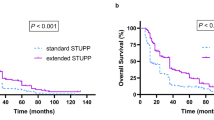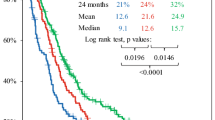Abstract
We report retrospective data on the feasibility and efficacy of prolonging adjuvant temozolomide (TMZ) more than 6 months after chemoradiotherapy completion in patients with glioblastoma (GBM). Molecular prognostic factors were assessed. Data from 46 patients were reviewed. Patients received postoperative irradiation, 60 Gy in 30 fractions, combined with concurrent TMZ, 75 mg/m2. Four weeks later, adjuvant TMZ was prescribed, 150–200 mg/m2 for a total of 24 cycles unless there was progression or toxicity. Tumor samples were tested for the following prognostic factors: EGFR overexpression, 1p19q deletion, p53 overexpression and proliferation index. Overall survival (OS) was 84.8% at 6 months, 54.3% at 12 months, 26.1% at 18 months, and 21.7% at 24 months. Progression-free survival (PFS) was 73.9% at 6 months, 34.8% at 12 months, 15.2% at 18 months and 10.4% at 24 months. In the adjuvant phase, no treatment disruption for toxicity was necessary but eight patients required dose adaptation because of side effects. No significant molecular prognostic factor was evidenced for OS. We found that p53 overexpression was the only significant prognostic factor for PFS, with a median PFS of 9.3 months versus 7 months for patients without p53 overexpression (P = 0.031). This study suggests that delivering adjuvant TMZ therapy for more than 6 months is feasible in patients with GBM. Efficacy data warrant further prospective assessment with the focus on molecular prognostic factors, such as p53 overexpression, which was found to be the only significant molecular prognostic factor for outcome.

Similar content being viewed by others
References
Stupp R, Mason WP, van den Bent MJ, Weller M, Fisher B, Taphoorn MJ et al (2005) Radiotherapy plus concomitant and adjuvant TMZ for GBM. N Engl J Med 352:987–996
Mirimanoff RO (2006) The evolution of chemoradiation for glioblastoma: a modern success story. Curr Oncol Rep 8:50–53
Weller M, Felsberg J, Hartmann C et al (2009) Molecular predictors of progression-free and overall survival in patients with newly diagnosed GBM: a prospective translational study of the German Glioma Network. J Clin Oncol 27:5743–5750
Haberer S, Assouline A, Mazeron JJ (2010) Normal tissue tolerance to external beam radiation therapy: brain and hypophysis. Cancer Radiother 14:263–268
Louis DN, Ohgaki H, Wiestler OD, Cavenee WK (eds) (2007) WHO classification of tumours of the central nervous system. IARC, Lyon
Ambros PF, Ambros IM (2001) Pathology and biology guidelines for resectable and unresectable neuroblastic tumors and bone marrow examination guidelines. Med Pediatr Oncol 37:492–504
Mason WP, Maestro RD, Eisenstat D, Forsyth P, Fulton D, Laperriere N et al (2007) Canadian recommendations for the treatment of glioblastoma multiforme. Curr Oncol 14:110–117
Hau P, Koch D, Hundsberger T, Marg E, Bauer B, Rudolph R et al (2007) Safety and feasibility of long-term temozolomide treatment in patients with high-grade glioma. Neurology 68:688–690
Baurain J, Boterberg T, Devriendt D, Hammouch F, Cosnard G, Whenham N, Clement PM, Mitine C, Renard L (2010) Interim analysis of the randomized PATSGO trial evaluating the prolongation of adjuvant temozolomide in newly diagnosed glioblastoma patients. J Clin Oncol 28:204 (abstract)
Pollack IF, Finkelstein SD, Burnham J, Holmes EJ, Hamilton RL, Yates AJ, Finlay JL, Sposto R, Children’s Cancer Group (2001) Age and TP53 mutation frequency in childhood malignant gliomas: results in a multi-institutional cohort. Cancer Res 61:7404–7407
Miyagami M, Nakamura S (1998) Evaluation of p53 protein expression and proliferative potential based on the MIB-1 positive index in astrocytic gliomas. Neuropathology 18:154–161
Miyagami M, Tazoe M, Nakamura S (1998) Expression of vascular endothelial growth factor and p53 protein in association with neovascularization in human malignant gliomas. Brain Tumor Pathol 15:95–100
Hendriksen EM, Span PN, Schuuring J, Peters JP, Sweep FC, van der Kogel AJ, Bussink J (2009) Angiogenesis, hypoxia and VEGF expression during tumour growth in a human xenograft tumour model. Microvasc Res 77:96–103
Kang HC, Kim CY, Han JH, Choe GY, Kim JH, Kim JH, Kim IA (2011) Pseudoprogression in patients with malignant gliomas treated with concurrent TMZ and radiotherapy: potential role of p53. J Neurooncol 102:157–162
Burton EC, Lamborn KR, Forsyth P et al (2002) Aberrant p53, mdm2, and proliferation differ in GBMs from long-term compared with typical survivors. Clin Cancer Res 8:180–187
Bocangel D, Sengupta S, Mitra S, Bhakat KK (2009) p53-Mediated down-regulation of the human DNA repair gene O6-methylguanine-DNA methyltransferase (MGMT) via interaction with Sp1 transcription factor. Anticancer Res 29:3741–3750
Conflicts of interest
None.
Author information
Authors and Affiliations
Corresponding author
Rights and permissions
About this article
Cite this article
Malkoun, N., Chargari, C., Forest, F. et al. Prolonged temozolomide for treatment of glioblastoma: preliminary clinical results and prognostic value of p53 overexpression. J Neurooncol 106, 127–133 (2012). https://doi.org/10.1007/s11060-011-0643-0
Received:
Accepted:
Published:
Issue Date:
DOI: https://doi.org/10.1007/s11060-011-0643-0




